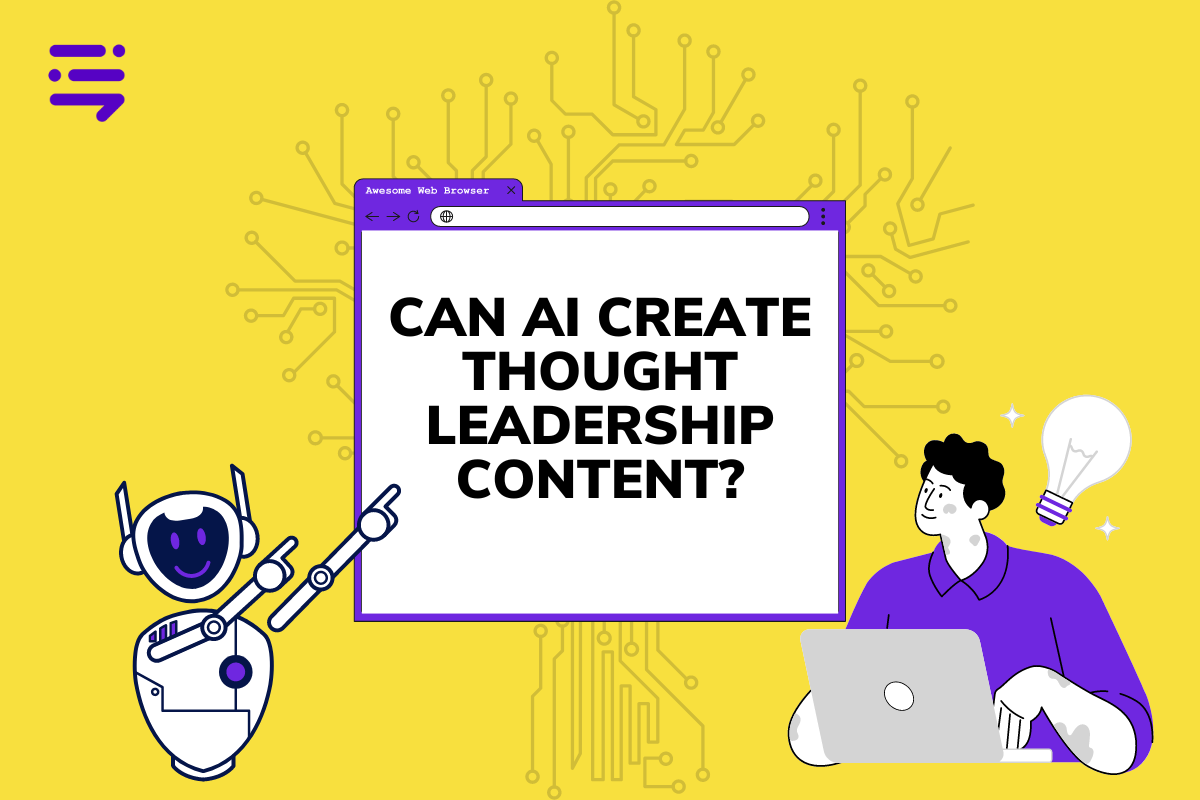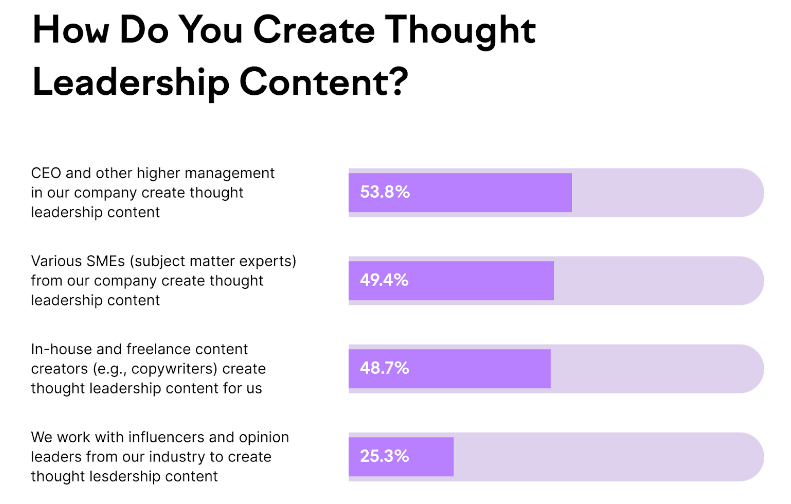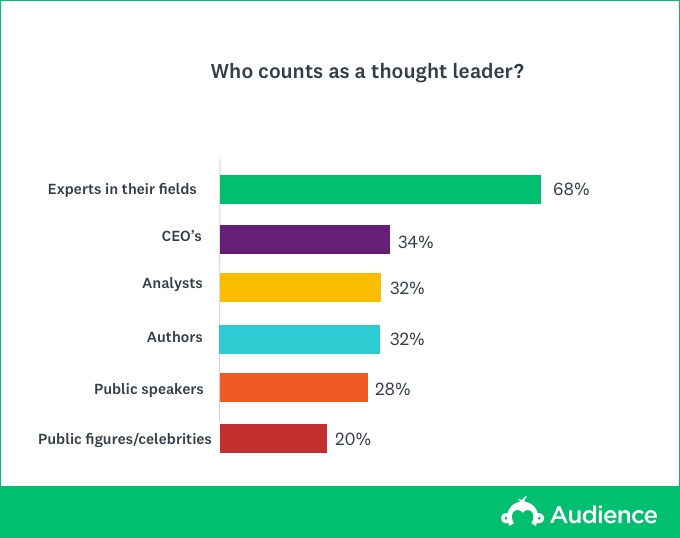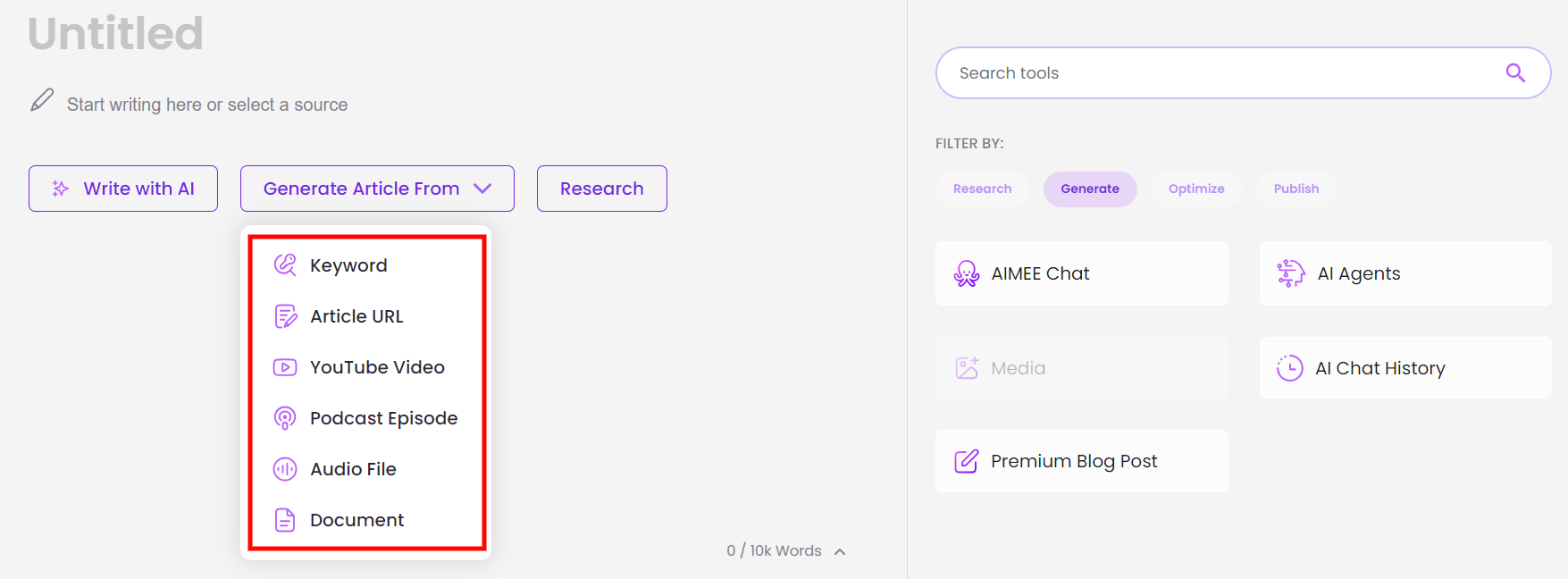Discover top guides, trends, tips and expertise from AIO Writers
Can AI Create Thought Leadership Content? AI Can’t Think For You… Yet
Justin McGill
Tuesday, 11th Apr 2023
Artificial intelligence (AI) is everywhere — sometimes we’re not even aware of its presence in our daily lives.
AI is in your living room, at your office, on your smartwatch and smartphone, and even in your cars. But can AI think for you?
Particularly in marketing, can AI create thought leadership content?
Artificial intelligence is already making a huge impact on content marketing. A human writer takes an average of four hours to write a single blog post with 1,400 words. With a content marketing automation platform like BrandWell, you get a complete article with 3,000 words in under five minutes!
And in terms of quality? 82% of marketers think AI-generated content is just as good (or better!) than human-written content.
AI-driven writing tools generate content by learning what’s already out there. But what if you want to establish yourself as an expert or authority in a very new niche? Can AI create thought leadership content for you?
In this blog post, we will explore the potential of AI to generate content that can position your organization as an industry leader.
You will learn:
- The definition of thought leadership content.
- The benefits of this type of content.
- How to automate impactful thought-leadership content creation.
- Best practices for creating AI-generated thought leadership content.
By understanding the capabilities of AI in crafting high-quality thought leadership pieces, you’ll be better equipped to leverage this technology for success within your niche.
Table Of Contents:
- The Role of Thought Leadership in Marketing
- Can AI Create Thought Leadership Content? How to Blend AI + Thought Leadership
- Optimizing Your Thought Leadership Content’s Performance
- Limitations of AI in Creating Thought Leadership Content
- Creating Tailored Content for Diverse Audience Segments
- FAQs – Can AI Create Thought Leadership Content?
- Can AI Create Thought Leadership Content? Yes… But Only with the Right Strategy
The Role of Thought Leadership in Marketing
Thought leadership is a powerful tool for marketing products and services. By publishing impactful thought leadership pieces, you can demonstrate your expertise in your field and showcase how your product or service could be used to solve specific problems.
What is Thought Leadership Content?
Thought leadership content is an opinion or viewpoint piece created by a subject expert. It’s designed to inform, educate, and entertain readers rather than promote the brand or sell products.
In 2021, 66% of decision-makers reported a boom in thought leadership content spurred by the pandemic.
The purpose of thought leadership is to share valuable opinions that challenge readers’ ways of thinking. Thought leadership pieces should choose a side and be based on personal experience and expertise for maximum impact.
Offering unique perspectives on relevant topics, your goal should be to provide readers with actionable advice they can use right away so that they feel like they are getting something out of reading your work instead of simply consuming more noise online.
Impactful thought leadership pieces should offer something new and different from what your audience has seen before. You can do this through compelling storytelling or creative data visualization techniques — whatever it takes to get your message across in an engaging way.
Make sure you include facts and figures as supporting evidence for any claims you make in your article; otherwise, your target audience won’t take it seriously.

Source: Semrush
How to Become a Thought Leader in Your Industry
Thought leadership is not just about sharing knowledge. Thought leadership content helps enhance your position as an expert in your field by consistently producing high-quality content that provides readers with real value. This establishes you as a trusted source of information and can help to build your brand’s credibility and authority within the industry.
Becoming a thought leader has many benefits for both individuals and organizations. Not only does it increase visibility and recognition, but it also serves as an effective way to differentiate yourself from competitors.
So how do you become a thought leader? The first step is creating quality content.
How to Create Brilliant Thought Leadership Content
First, ask yourself these questions:
- What challenges do my customers face?
- What are their biggest issues?
- What sparks their curiosity?
Building audience personas, running surveys, and doing some social listening are all great ways to learn more about your audience’s needs. You can then use this information to create thought leadership content for them.
Gaining expertise in your field is essential in creating rich thought leadership content. According to SurveyMonkey’s Thought Leadership report, 68% of respondents agree that true thought leaders have expert knowledge.

Image Source: Survey Monkey
Being an expert means you don’t need to look up a topic — you know it inside out. If you’re working outside your area of expertise, consider interviewing multiple subject matter experts in your network or reading industry-specific books and articles on the topic at hand.
For brand consistency, use the same language across all pieces — whether your tone is humorous or serious, casual or formal, make sure there’s always familiarity present so readers recognize your work.
Now that you know how to create thought leadership content, it’s time to ask: Can AI create thought leadership content?
Can AI Create Thought Leadership Content? How to Blend AI + Thought Leadership
Artificial intelligence has the potential to revolutionize thought leadership content creation by augmenting human efforts with AI-powered tools. These technologies can help scale production without sacrificing creativity or quality, enabling businesses and individuals to share their expertise more efficiently on a global scale.
Learn more about AI writing and how you can blend AI with thought leadership.
When it comes to creating engaging thought leadership content, the biggest challenge is getting the author’s expertise and time. Most thought leaders don’t have the ability or desire to write a piece of content themselves. This is where AI can shine.
The first step in creating thought leadership content is writing a blog outline. You can do this manually by interviewing the author and writing down their thoughts and messages. Record them talking about the topic and ask open-ended questions.
If your author has already written blog posts, research papers, and presentations, you can use these as sources of information instead of starting from scratch. This saves both time and energy while still providing valuable insights into what makes your subject matter expert tick.
Once you have your author’s talking points, you can run them through BrandWell and automate your entire writing process — from creating a blog outline to the actual writing and publishing of your work.
Here’s how to do it:
First, log into your BrandWell account and click RankWell in the left column to select the project you want to work on.
Click “Write Article” and choose “Document” from the six input options.


The document-to-blog feature allows you to upload your interview notes from a Word, PowerPoint, or PDF file.


You can specify a keyword you want to rank for, choose a word count range, and provide specific instructions on what you want the AI to include (or exclude) in the article. You can also assign this task to a team member and schedule the publishing date and time.
When you’re done, just click “Write Post Now” to create your thought leadership piece or save this brief to your content planner/calendar and run it at a later date.
Optimizing Your Thought Leadership Content’s Performance
Now that you have your content written, what’s next?
1. Research and Fact-Check
While AI makes it possible to automate impactful thought-leadership content creation, this is just a starting point. It’s important not to rely solely on AI without conducting thorough research. This involves validating generated ideas against credible resources such as Statista, Pew Research Center, or other reputable industry publications before incorporating them into your articles.
- Analyze primary data sources like surveys or interviews conducted by experts in the field.
- Evaluate secondary data from reliable sources like government reports or academic journals.
- Cross-reference multiple resources to ensure the accuracy and credibility of the information presented in your article.
By combining AI-generated insights with comprehensive research, you can create thought leadership content that not only showcases your expertise but also provides valuable information to your audience.
2. Add a Human Touch to AI-Generated Thought Leadership Content
Anecdotes, case studies, and best practices from thought leaders should be blended with AI-driven data to create engaging content that builds credibility. This human touch not only makes the content more engaging but also helps establish credibility with readers.
To create truly impactful thought leadership content, subject matter experts should leverage both their personal experiences and the data-driven insights generated by AI-powered tools. By combining these elements effectively, you can craft compelling narratives that resonate with your audience while maintaining a strong foundation of evidence-based information.
- Analyze trends: Use AI-generated insights to identify emerging trends or challenges within your industry.
- Add context: Share relevant personal stories or examples from your own experience that help illustrate key points and provide valuable context for readers.
- Demonstrate expertise: Showcase your unique perspective as an industry expert through practical advice and actionable recommendations based on real-world scenarios.
3. Be Authentic
Including authentic personal stories in thought leadership pieces can be highly effective at capturing reader interest. However, it’s crucial to strike a balance between sharing relatable experiences and maintaining professional credibility. To achieve this delicate balance, consider the following tips:
- Be genuine: Share honest accounts of your experiences without exaggerating or embellishing for effect. Readers can often sense when a story is fabricated, which may damage your credibility.
- Maintain relevance: Ensure that any personal anecdotes included in your content are directly related to the topic at hand and contribute meaningfully to the overall narrative.
- Avoid oversharing: While it’s essential to be open and transparent with readers, avoid sharing overly personal details that may detract from the primary focus of your thought leadership piece.
Incorporating personal stories not only creates engaging thought leadership content but also helps establish trust with readers by showcasing real-world experience alongside data-driven insights provided by AI tools.
By striking a balance between authenticity and professionalism, authors can create compelling narratives that resonate with their target audience while maintaining credibility as industry experts.
Limitations of AI in Creating Thought Leadership Content
Can AI create thought leadership content? Yes, it can.
But while AI can revolutionize thought leadership content creation, it can never replace the human thought leader.
Why?
Because it cannot think for you. At least, not at this time.
Here are some of the challenges of using AI to generate thought leadership pieces.
- Limited creativity: While AI-generated content may be well-organized, it often lacks the creative flair necessary for engaging audiences. Human input remains crucial in infusing personality or industry-specific insights that resonate with readers.
- Attribution problems: Another challenge when using AI-generated content is ensuring proper attribution. Since much of the information provided by these tools comes from existing sources, it’s important to verify facts and give credit where it’s due — a task for human authors who understand ethical citation practices.
- Trustworthiness concerns: Lastly, trust issues surround AI-generated content. Readers want authentic perspectives backed by real-world experience. Relying solely on machine learning algorithms might lead some audiences to question an article’s credibility. Therefore, balancing AI-generated insights with human expertise is essential to maintain that trust.
While modern AI writing tools offer significant benefits in terms of organizing thoughts and creating logical content structure, they cannot replace the creativity and authenticity that come from human authors. Thought leaders should leverage these technologies as a means to augment their content creation efforts rather than relying on them entirely.
So if AI can’t think for you, what else can it do aside from structuring blog outlines and writing a baseline draft for your article?
Developing Topics
If you are running out of topics or suffering from a severe case of writer’s block, artificial intelligence can help generate new ideas through topic modeling techniques. Tools like MonkeyLearn’s Topic Analysis API use machine learning algorithms to identify trends within large datasets of text from social media posts or industry publications. This allows marketers and thought leaders alike to explore emerging themes relevant to their field of expertise.
Staying Ahead of Industry Developments
To maintain their status as thought leaders, experts must stay informed about the latest advancements within their respective fields. By leveraging generative AI technology, you can access real-time data on hot trends and use this information to inform your content strategy. This ensures you remain at the forefront of key issues and solutions within your niche.
Creating Tailored Content for Diverse Audience Segments
To effectively engage different audience segments, thought leaders need to create customized content that addresses specific needs or interests. With advanced AI-powered tools, you can easily generate multiple versions of an article optimized for distinct demographics or platforms – ultimately expanding your brand’s reach and impact.
- Social Media: Short-form posts accompanied by eye-catching visuals are ideal for capturing attention on platforms like Facebook, Twitter, or LinkedIn.
- Email Campaigns: Thought leadership content can be condensed into digestible newsletters, providing subscribers with valuable insights directly to their inboxes.
- Paid Search Promotions: By targeting specific keywords related to industry trends or challenges, thought leaders can ensure that their content is seen by those actively searching for solutions.
Incorporating generative AI technology into the thought leadership content creation process not only streamlines production but also empowers creators to produce highly relevant and engaging material. As these tools continue to advance, they will play an increasingly significant role in shaping the future of thought leadership across various industries.
FAQs – Can AI Create Thought Leadership Content?
How do you create thought leadership content?
To create thought leadership content, identify your target audience, develop a unique perspective on industry topics, conduct thorough research to support your ideas, craft engaging and informative narratives, incorporate personal anecdotes for authenticity, and use a brand growth tool like BrandWell to optimize and scale the content.
Can AI create content?
Yes, AI can create content using advanced natural language processing algorithms. Tools like BrandWell enable the generation of high-quality text across various formats including blog posts and long-form articles while maintaining coherence and relevance.
Can AI Create Thought Leadership Content? Yes… But Only with the Right Strategy
So, is AI content writing worth it for thought leadership despite its flaws?
AI-generated thought leadership content can be a powerful tool for businesses looking to create high-quality, authoritative content quickly. While there are challenges associated with using AI for this purpose, companies can leverage its capabilities to their advantage.
Ultimately, it is up to each business owner or marketer to decide if they want to take on the challenge of incorporating artificial intelligence into their own marketing strategy. When done correctly, AI can help create thought leadership content faster and become an invaluable asset when reaching out to potential customers online.

UNLOCK YOUR POTENTIAL
Long Headline that highlights Value Proposition of Lead Magnet
Grab a front row seat to our video masterclasses, interviews, case studies, tutorials, and guides.



